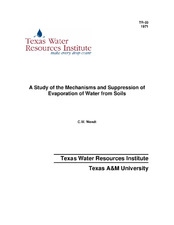| dc.description.abstract | Extensive greenhouse experiments were conducted to evaluate chemicals not previously studied extensively for their potential as evaporation suppressants. Included in the studies were crude oil, anionics, cationics, nonionics, silicones, polysaccharide-gum mixtures, oil-latex mixtures, fatty alcohols, and reflectance materials. Of these compounds, only crude oil and crude oil-cationic mixtures were effective in suppressing soil water evaporation significantly when applied to smooth Olton loam wet soil surfaces. The cationics apparently acted as a bond between the cation exchange capacity of the soil. Rates of crude oil studies were 473 l/ha (50 gal/acre) to 9460 l/ha (1000 gal/acre). In some cases the crude oil affected emergence of tomatoes and onions, but did not affect the emergence of cucumbers.
More extensive studies were conducted in controlled environment facilities to determine the mechanisms of suppression by crude oil and to delineate the influence of various soil surfaces and environmental parameters on the effectiveness of the crude oil-treated surfaces. Rates studied included 946, 2038, and 4730 l/ha (100, 300, and 500 gal/acre). Two mechanisms of suppression are apparently involved when crude oil is applied to a smooth wet soil surface. Immediately following application, the mechanism is the same as that when oil is applied to a free water surface. Following this an increase in evaporation occurs, but the rate is much less than that from an untreated soil surface indicating the formation of a barrier which slows down the movement of liquid water to the soil surface.
The crude oil was most effective on smooth wet soil surfaces and least effective on rough dry surfaces. Crude oil-treated surfaces were effective against wind speeds up to 6.5 m/sec (15 mph) for 3-4 days at rates as low as 946 l/ha (100 gal/acre). As soil temperature was increased from 10¡ C. to 38¡ C., crude oil-treated surfaces were less effective in suppressing evaporation due to the increased vapor pressure of the soil water. Varying the light intensity from 0.15 to 0.60 Langleys/min did not influence the evaporation from crude oil surfaces in the controlled environment chamber. This is not surprising since it is net radiation, not solar radiation, which is a part of the energy balance. As was expected, the evaporation losses increased as the vapor pressure deficit of the air was increased from both the untreated and crude oil-treated surfaces.
Field studies to evaluate the practical potential of crude oil in the field were disappointing. Crude oil was sprayed at the rate of 2838 l/ha (300 gal/acre) and floated at rates of 473 to 1892 l/ha (50 to 200 gal/acre) on the surface of irrigation water to apply it to soil surfaces in cotton during the growing season. A savings of moisture due to the application of crude oil was noted. However, there was no consistent increase in the yield of cotton.
Crude oil appears to be an effective evaporation suppressant when applied to a smooth wet soil surface. Further, it is most effective immediately after water applications when the soil water evaporation rate is the highest, and the most economical material reported to date ($3 - $18 per acre or $.06 a gallon for material). However, the application of crude oil to a smooth wet soil surface immediately following water applications is a major problem.
During the field studies, it was noted that rain failed to penetrate the crude oil surface when the land was sloping. This finding is being investigated in another project on the use of crude oil as an aid in water harvesting. | en |


